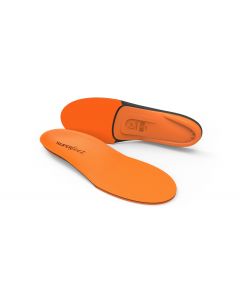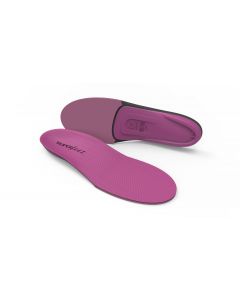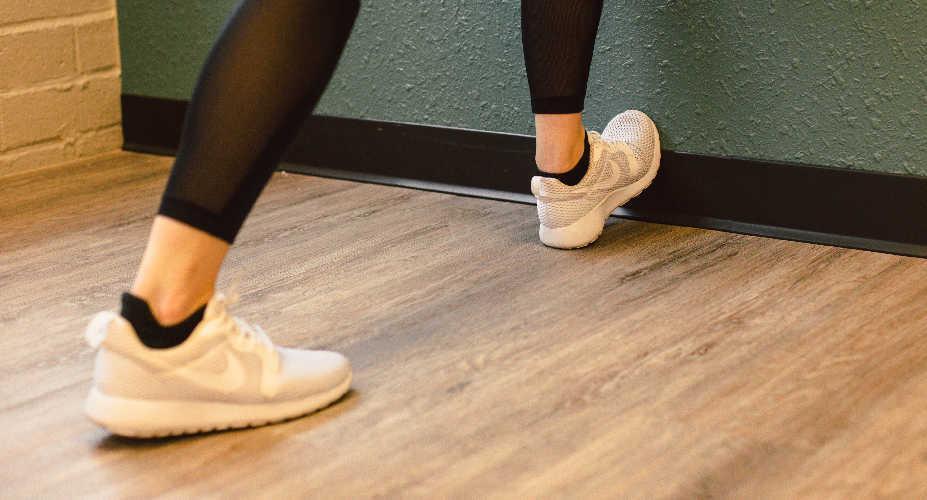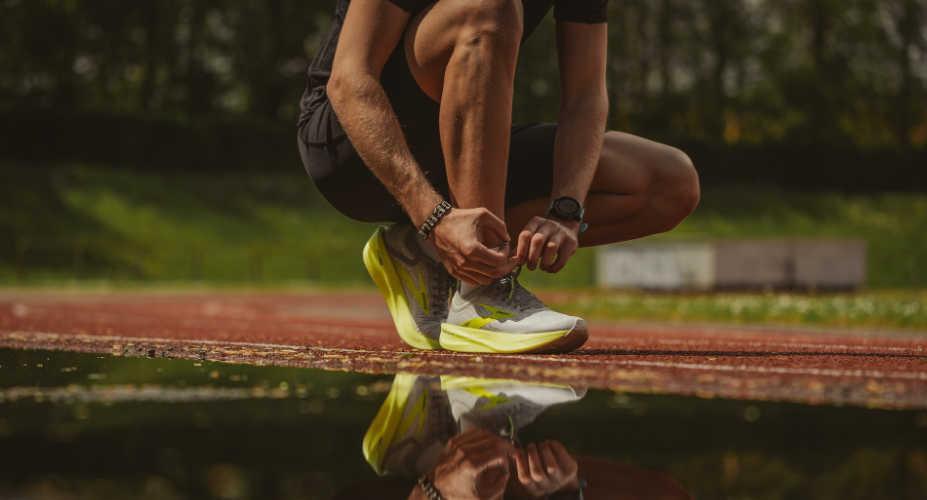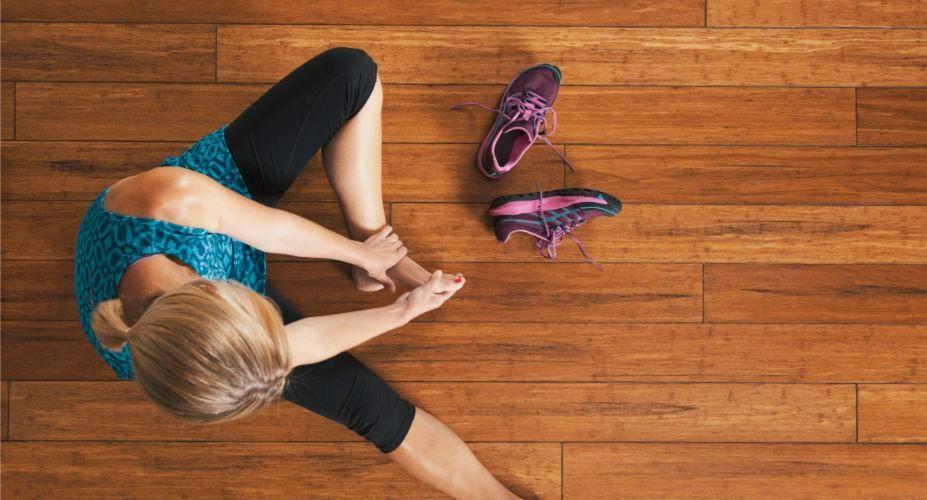
Written with contributions from Superfeet Wellness Experts and the Superfeet education team.
Just thinking about plantar fasciitis (plan-tar fass-E-eye-tis) will make even the hardiest athletes cringe.
Not only does the name sound scary, the amount of people that have suffered its wrath of agonizing heel pain will stop you in your tracks. In the running and endurance world, plantar fasciitis is a mainstay and common topic of discussion. Less discussed though is the enormous amount of average non-athletes that also suffer from the condition.
Let’s look at the facts, dispel the myths and go over a few treatment options, including the best insoles for plantar fasciitis.
WHAT IS PLANTAR FASCIITIS?
Pain in the heel can be attributed to many different conditions caused by a variety of factors that need a range of treatments. We’re focusing just on plantar fasciitis, an intense but treatable pain usually felt on the bottom of the heel right where the calcaneus bone meets the plantar fascia tissue.
Plantar fasciitis is inflammation caused by excessive stretching of the tissue on the bottom of your foot. This broad connective structure is called the plantar fascia and acts like a big rubber band connecting your heel bone to your toes. It is the last line of support as your foot hits the ground.
When walking barefoot on a soft surface, the plantar fascia can easily handle the forces pushing down on it. However, hours of work or running on hard surfaces, especially in flat shoes, can put too much strain on the plantar fascia and cause immense pain at the back of the foot where the fascia tissue meets the heel bone.
An unstable foot may lead to additional stress placed on the plantar fascia during walking, running and prolonged standing. This is the most common cause of “heel pain,” though the heel is not the only area in which the plantar fascia can become inflamed.
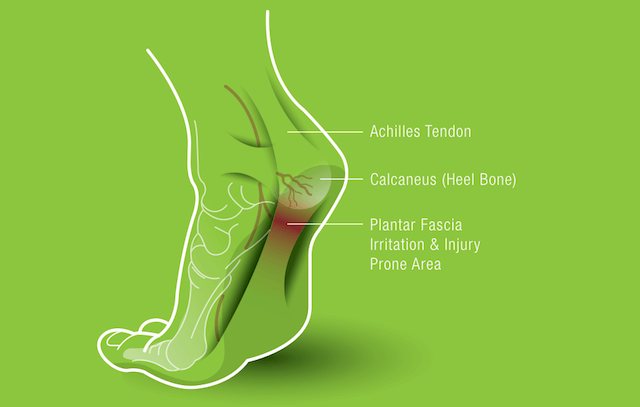

WHAT CAUSES PLANTAR FASCIITIS?
The plantar fascia plays a crucial role in helping your foot transition into the propulsive phase of the gait cycle. Like a shock absorber on a car, the foot has two primary motions: a compression phase, called pronation, and a propulsive phase, called supination.
The trouble comes when the foot pronates for a longer period than it should. Like a shock absorber that is already fully compressed (or close to it) at a moment of impact, the shock bottoms out and the ride is a lot less comfortable. When a foot remains pronated for a longer period, it may affect how it absorbs impact and can make standing, walking or running a lot less comfortable, especially on hard surfaces in flat, unsupportive shoes.
A change in the amount of force put on your plantar fascia might trigger plantar fasciitis. For example, if you add miles to your daily run or change your route to run more downhill – your feet experience added force thanks to gravity. If you walk to work and suddenly find yourself with a longer commute or your job requires lifting heavy loads, you will inevitably put added strain on your feet.
The strength of your muscles not only in your feet but your entire lower body could also be a factor when it comes to developing plantar fasciitis. If the muscles in your feet are weak, the plantar fascia picks up the slack to keep your supported. The muscles in your legs and even hips are also vital for stability and help absorb some forces while you move. Your feet could suffer the consequences of weak or fatigued legs. On the flipside, well supported feet can help strengthen and stabilize the complex system of bones, ligaments and muscles working together above the ankle as well as below it, allowing you to feel your best.
WHO IS LIKELY TO DEVELOP PLANTAR FASCIITIS?
Plantar fascia tissue can lose elasticity over time for a variety of reasons, including sports activity, prolonged standing and high stress or pressure under the heel. Runners, people who are overweight and those who have inadequate support in their footwear are most at risk of developing plantar fasciitis.
Athletes participating in long, high-intensity workouts are naturally likely to suffer from plantar fasciitis. Running ultra-marathons across uneven terrain, skiing black diamond slopes or giving it your all on the 400 meter hurdles all obviously increase the strain on your feet.
But there are plenty of scenarios in everyday life that put stress on your plantar fascia as well. Working a job that requires standing for most of the day, for example, or walking a long commute in flat dress shoes or high heels.
In shoes with good arch support, especially when combined with orthotic insoles for plantar fasciitis, the plantar fascia has a cushioned structure that allows the tissue to keep its natural shape no matter how hard the ground, instead of stretching and straining to remain stable.
SYMPTOMS OF PLANTAR FASCIITIS
Symptoms include sharp pain and inflammation across the bottom of your foot, specifically near the heel. You’ll most likely feel it when you first get out of bed, or after a day spent on your feet – particularly if you stand on hard surfaces for extended periods of time.
If your pain is relatively new, walking and working the muscles of your feet may provide relief temporarily. Plantar fasciitis discomfort usually flares up first thing in the morning because the plantar fascia tissue on the bottom of the foot can tighten and contract while you sleep. Unless your prone to sleepwalking or kicking off the covers, your feet are at rest overnight, giving the plantar fascia time to settle into a less protracted state. Taking your first steps out of bed in the morning stretches the “rubber band” which can trigger pain.
The same thing can happen even after sitting for just an hour or two. The worst of the soreness may have appeared to subside but as soon as you get on your feet again, it returns with a vengeance.
As the inflammation gets worse, the pain becomes increasingly constant throughout the day. Not only running and walking but even just standing can be excruciating and unbearable.
It is important to make sure the pain in your foot is in fact plantar fasciitis and not something else that may feel similar but actually requires a different set of treatments.
One common source of discomfort in that area of the foot is bruising of the fat pad that protects your heel bone and cushions each step. This usually comes from stepping on something sharp or hard and can be treated simply by giving your heel extra cushion and resting your foot as often as possible. Once the bruising has had time to heal, you’ll be pain free! If only plantar fasciitis were so easy.
Sometimes tendonitis (inflammation in the tendons that connect muscles to bones) in the heel area can be confused with plantar fasciitis. If the pain stems from the back of your foot near your Achilles tendon or the lower inside area near the arch of your foot, the pain is more than likely affecting your tendons, not your plantar fascia. If you feel stinging on the underside of your foot where your heel bone meets your arch tissue, there is a good chance it’s plantar fasciitis.
HOW TO TREAT PLANTAR FASCIITIS PAIN
The most obvious, if not always doable, way to immediately help relieve plantar fasciitis pain is to decrease the load on your feet. In other words, stay off your feet as much as possible. However, for many people, it’s simply not feasible to sit and relax most of the day. Reducing the load on your feet, and therefore lessening the strain on your plantar fascia, can start with small things like switching your daily run to a daily bike ride or taking the bus to work instead of walking, if possible.
In conjunction with giving your feet a rest, there are a few plantar fasciitis stretches and muscle strengthening exercises that can relieve pain and help prevent future injury. Stretching the plantar fascia while massaging the pain point, stretching and training your calves and even “toe yoga” can all help treat plantar fasciitis.
Staying off your feet and stretching when possible will certainly help you heal, but what about the times when walking or running are unavoidable? Is there a way to put force on your plantar fascia without causing more pain? The answer is yes, with the right support.
One of the best things you can do to not only treat your pain in the short term but also prevent it from coming back in the future is to invest in the right pair of plantar fasciitis inserts. Because the plantar fascia is the main structure making up the arch of your foot, keeping it properly supported is key. An insole constructed using soft foam combined with durable arch support not only cushions the foot but keeps it stable and supported in its natural shape, even when standing for long hours on hard surfaces.
HOW TO CHOOSE THE BEST INSOLES FOR PLANTAR FASCIITIS PAIN
Not all insoles are created equal. Orthotics for plantar fasciitis usually have both cushioned foam for comfort and strong arch support for stability. The softness of cheap gel inserts may be appealing for temporary relief but won’t solve the problem, while orthotics prescribed by a podiatrist may offer a custom fit but are expensive and may only work in certain shoes.
Important things to consider when choosing plantar fasciitis insoles are the fit, support, shock absorption, size, material and volume. While the highest priority is to find what is most comfortable under your feet, these six attributes can help you narrow down your search and decide what will work best for you.
FIT
Finding the right fit is central to choosing an insole. Some are made for very arched feet while others work for those flatter-footed among us. An insole should feel supportive but not intrusive and help keep the foot aligned in its natural shape.
SUPPORT
Speaking of a foot’s natural shape, proper arch support is one of the most important things to keep in mind when buying a plantar fasciitis insole. A durable cap that cradles the heel and extends the length of the arch will keep the plantar fascia tissue from straining during each step.
SHOCK ABSORPTION
While firm, structured support is great at keeping the plantar fascia in its natural shape, shock-absorbing foam is also essential to counteract the hard surfaces most people walk on every day and keep your feet feeling oh so comfortable.
SIZE
Ideally, your insoles fit perfectly under your feet and in your favorite shoes. Luckily, Superfeet insoles are trim-to-fit, meaning you can match them exactly to the liners that come in your shoes.
MATERIAL
The materials your insoles are made from are important to consider for a variety of reasons. They not only determine how the insole will feel immediately but also its long-term durability. Certain materials can provide extra benefits like antibacterial properties and odor control as well.
VOLUME
No, this doesn’t refer to the sound an insole makes when you take a step (for the record, if your insoles are making sounds, something’s wrong!). The volume of an insole is how much space it takes up in your shoe. Insoles with the thickest foam and highest arch are meant for roomier footwear while thin insoles can fit in tight-fitting shoes.
THE BEST INSOLES FOR PLANTAR FASCIITIS – RELIEVING PLANTAR FASCIA PAIN
Superfeet insoles’ contoured shape stabilizes the feet, helping reduce some of the stress on the plantar fascia. The structured heel cup positions the soft tissue under the heel bone to help reduce the effect of impact forces on the already inflamed structure. By giving feet the stability and comfort they need, Superfeet insoles do more than remedy most cases of plantar fasciitis, they may also help prevent it from happening in the first place.
Superfeet Casual Pain Relief and Run Pain Relief insoles are our best insoles for plantar fasciitis. Both feature an energizing foam layer that delivers cushioned comfort and an EVOLyte® carbon fiber cap that provides responsive, weight-defying support, thanks to a proprietary carbon fiber and polymer blend. Add an independent heel stabilizer that keeps the pain-relieving structure closer to your foot and an antibacterial top cover and you have the all-around best insoles for premium comfort and effective pain relief. Casual Pain Relief insoles work great for casual shoes and day-to-day life while Run Pain Relief insoles are designed for athletic shoes to provide relief all the way through the finish line.
Not sure which Superfeet insole works best for you? Take our insole finder quiz to find the perfect match for your feet!


